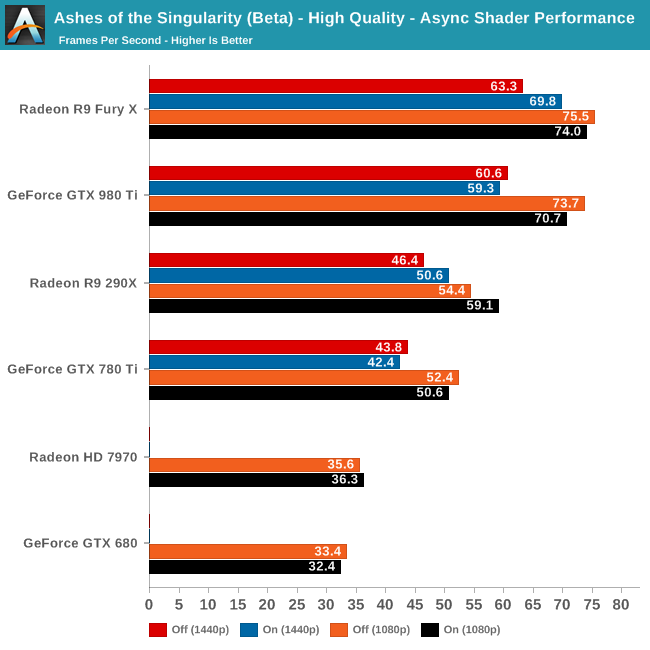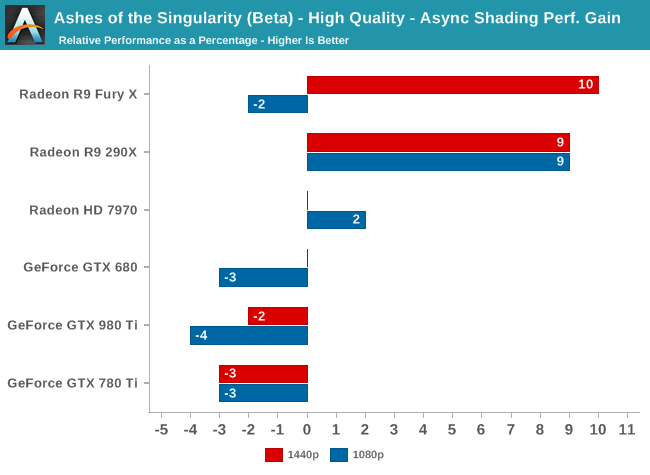Ashes of the Singularity Revisited: A Beta Look at DirectX 12 & Asynchronous Shading
by Daniel Williams & Ryan Smith on February 24, 2016 1:00 PM ESTThe Performance Impact of Asynchronous Shading
Finally, let’s take a look at Ashes’ latest addition to its stable of DX12 headlining features; asynchronous shading/compute. While earlier betas of the game implemented a very limited form of async shading, this latest beta contains a newer, more complex implementation of the technology, inspired in part by Oxide’s experiences with multi-GPU. As a result, async shading will potentially have a greater impact on performance than in earlier betas.
Update 02/24: NVIDIA sent a note over this afternoon letting us know that asynchornous shading is not enabled in their current drivers, hence the performance we are seeing here. Unfortunately they are not providing an ETA for when this feature will be enabled.

Since async shading is turned on by default in Ashes, what we’re essentially doing here is measuring the penalty for turning it off. Not unlike the DirectX 12 vs. DirectX 11 situation – and possibly even contributing to it – what we find depends heavily on the GPU vendor.

All NVIDIA cards suffer a minor regression in performance with async shading turned on. At a maximum of -4% it’s really not enough to justify disabling async shading, but at the same time it means that async shading is not providing NVIDIA with any benefit. With RTG cards on the other hand it’s almost always beneficial, with the benefit increasing with the overall performance of the card. In the case of the Fury X this means a 10% gain at 1440p, and though not plotted here, a similar gain at 4K.
These findings do go hand-in-hand with some of the basic performance goals of async shading, primarily that async shading can improve GPU utilization. At 4096 stream processors the Fury X has the most ALUs out of any card on these charts, and given its performance in other games, the numbers we see here lend credit to the theory that RTG isn’t always able to reach full utilization of those ALUs, particularly on Ashes. In which case async shading could be a big benefit going forward.
As for the NVIDIA cards, that’s a harder read. Is it that NVIDIA already has good ALU utilization? Or is it that their architectures can’t do enough with asynchronous execution to offset the scheduling penalty for using it? Either way, when it comes to Ashes NVIDIA isn’t gaining anything from async shading at this time.

Meanwhile pushing our fastest GPUs to their limit at Extreme quality only widens the gap. At 4K the Fury X picks up nearly 20% from async shading – though a much smaller 6% at 1440p – while the GTX 980 Ti continues to lose a couple of percent from enabling it. This outcome is somewhat surprising since at 4K we’d already expect the Fury X to be rather taxed, but clearly there’s quite a bit of shader headroom left unused.










153 Comments
View All Comments
Dug - Sunday, February 28, 2016 - link
Very bad would indicate that it would be unplayable.I'm playing fine at over 60fps on nvidia. Maybe I should trade it in for an R9 to get 63fps?
C3PC - Wednesday, March 16, 2016 - link
Not really, this is a beta for a game that is heavily embedded with AMD tech, the way the game handles it would favor AMDs implementation, it could go the other way for a game designed around Nvidia's implementation.Also, calling this bed performance of DX12? Maybe you should clarify that this is an implementation of 12_0 and not 12_1, I highly doubt AMD will fair as well as Nvidia under such circumstances.
jsntech - Wednesday, February 24, 2016 - link
For Nvidia to perform the same or worse between DX11 and DX12 seems like a pretty big thing to be addressed with just an 'optimization', especially compared to AMD's results. I guess we'll see when it's out of beta!Senti - Wednesday, February 24, 2016 - link
Well, being low-level DX12 leaves much less to driver, so there should be less miraculous fps gains by driver optimization than in DX11.mabellon - Wednesday, February 24, 2016 - link
Something I have been wondering about this game is whether the DX11 vs DX12 comparison is really valid. The game apparently pushes higher draw calls and takes advantage of DX12. But when running in DX11 mode, is it still trying to push all those unique draw calls or is it optimized like most DX11 games and using draw call instancing? (Sorry not a game dev, so I don't fully grok the particulars).Basically, if the game was designed and optimized for DX11 it might perform well but not have the visual fidelity of so many draw calls (unique unit visuals). So the real difference should have been visual quality. Instead I get the impression that the game was designed to push DX12 and then when in DX11 mode stresses the draw call limitations, over emphasizing the apparent gains. Am I wrong?
Currently it seems that porting a game from DX11 to DX12 nets up to a 50% improvement in framerates. The reality is more nuanced that existing games are clearly working around draw call limitations and thus won't see something quite so dramatic. Thoughts?
ImSpartacus - Wednesday, February 24, 2016 - link
I think you're probably right.Dx12 doesn't simply improve performance and nothing else. So the massive performance improvements probably aren't entirely fair.
extide - Wednesday, February 24, 2016 - link
It would have to use less draw calls for DX11 as hitting DX11 with the high number of calls you can do in DX12 would make it fall flat on it's face. I am sure the DX11 path is well optimised for DX11, I mean while this game is a big showcase for DX12, most people who play it will probably be on DX11 ...Denithor - Thursday, February 25, 2016 - link
People with nVidia cards will be playing in DX11 mode. People with AMD cards, even those three generations old, will be fine in DX12 mode with better eye candy and simultaneously better FPS.Friendly0Fire - Wednesday, February 24, 2016 - link
There's definitely quite a bit of that. Looking at the benchmark, a lot of the graphics design seems aimed at causing more draw calls (long-lasting smoke consisting of lots of unique particles, lots of small geometric details, etc.). While I'm absolutely convinced that DX12 will give better performance than DX11 in the long run and that the gap will be fairly large, I think this benchmark is definitely designed to overemphasize just how great DX12 is.jardows2 - Wednesday, February 24, 2016 - link
I would like to see how much of an impact the DX12 on a released game makes in the CPU world. Do you get better performance from multiple cores, or is it irrelevant? Speculation is that DX12 could change the normal paradigm for judging gaming performance on CPU's.